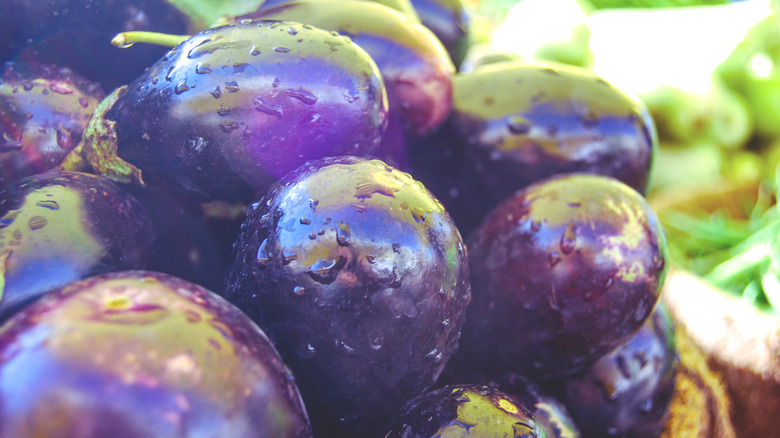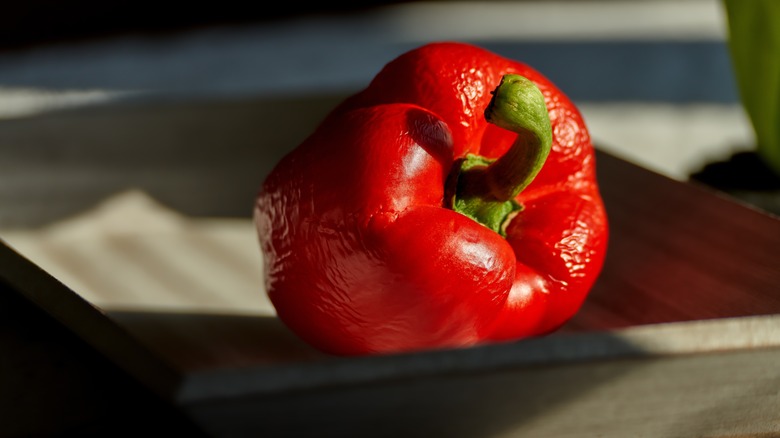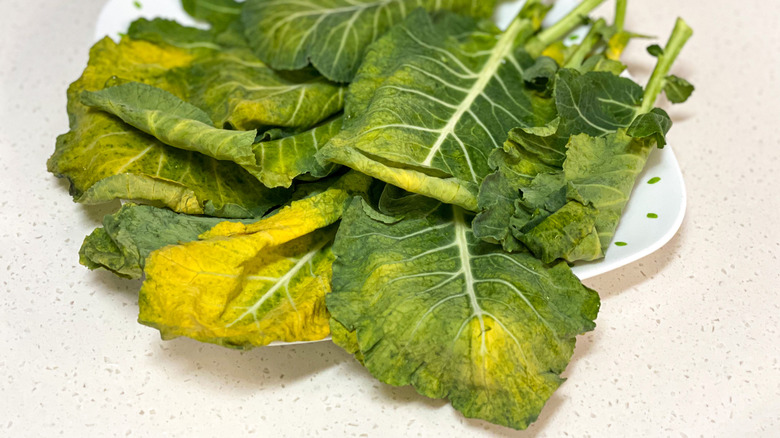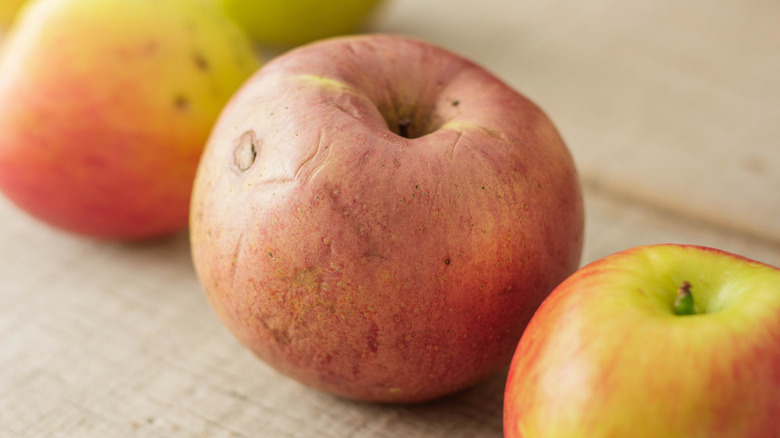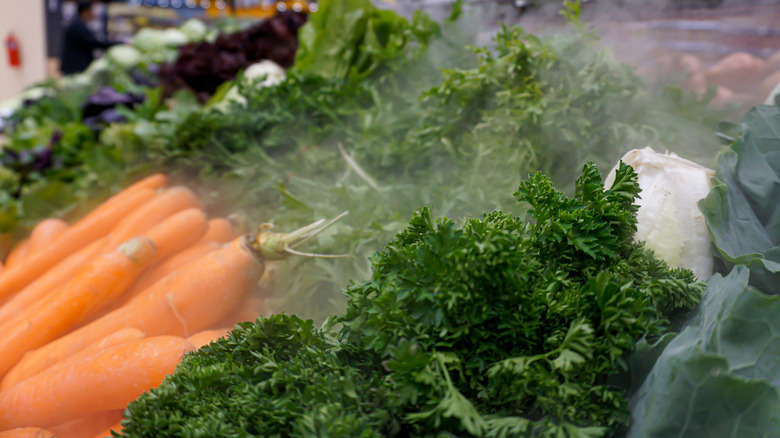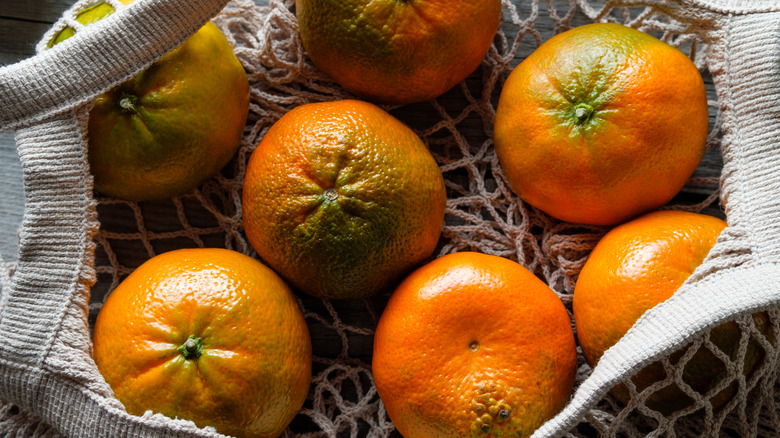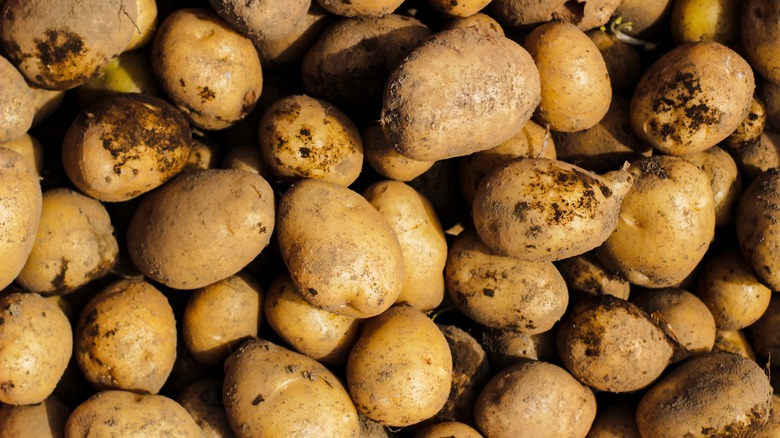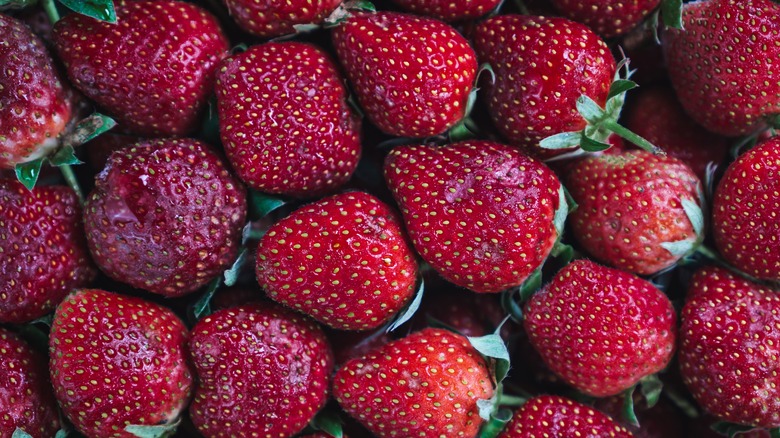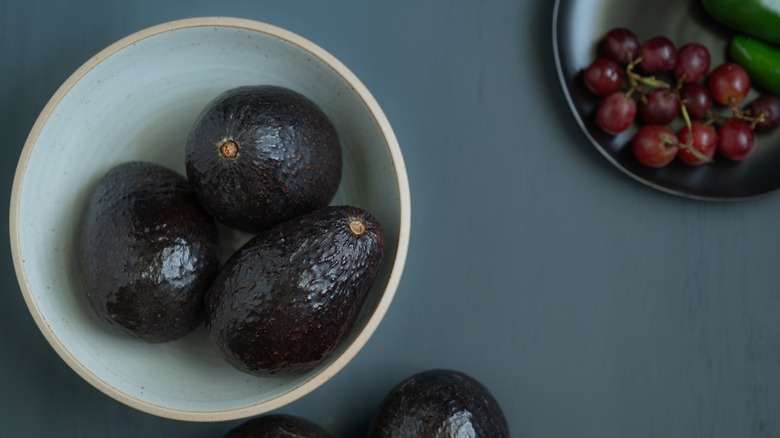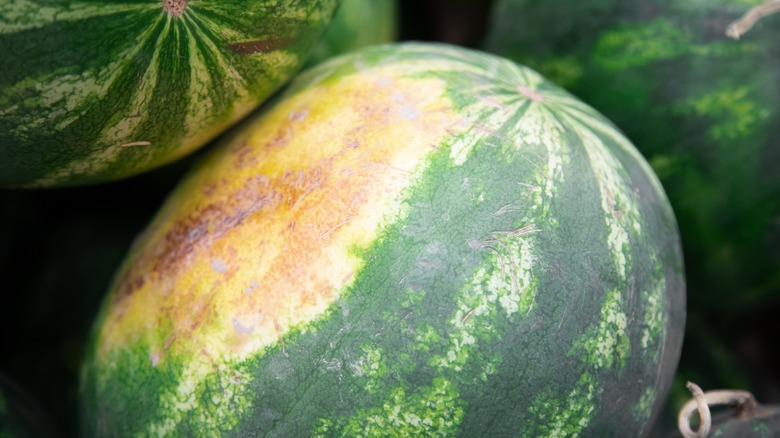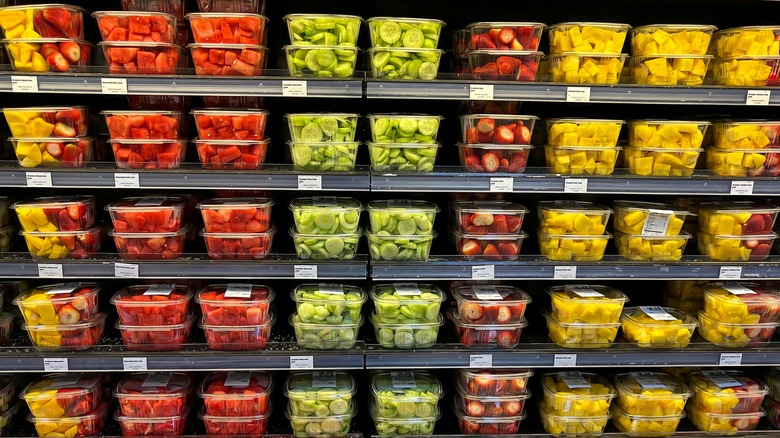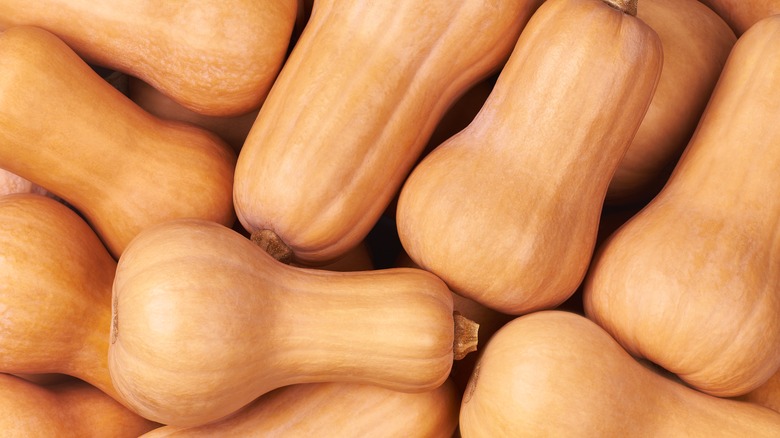12 Red Flags You Should Never Ignore In The Grocery Store Produce Department
In our modern world run by busy lives and the need for convenience, many aspects of our trips to the grocery store are automatic, especially when it comes to selecting produce. We know the store layout by heart and pick the most aesthetically pleasing fruits or veggies when available. But sometimes produce harbors certain red flags — some obvious, others less so — that lead to disappointment if selected in a hurry. It's not hard to accidentally bring home mushrooms that are already rancid or oranges that are not particularly juicy. While it's easy to avoid many telltale signs of bad produce, like mold, bruising, or unusual discoloration, there's a lot we don't consider when checking boxes on our grocery lists that could help guarantee we pick the best produce every time.
In order to ensure that you've got the most nutrient-dense options, the best price per quantity, and the fruits and veggies with the longest shelf life, here are 12 red flags to look for when choosing fruits or vegetables at the grocery store. These signs will help you opt for better choices instead.
1. Produce is dripping wet
A large selection of household produce is best preserved in a humid environment. This applies more to vegetables than fruits, which is why it's not uncommon to see automatic misting systems at grocery stores that periodically spray the veggies on display. There are many reasons why grocery stores use misters, but this method also has some potential risks. On the positive side, misting produce helps maintain the necessary moisture to prevent vegetables from becoming dehydrated, and benefits those that thrive in humidity, such as cabbages, eggplants, and radishes. But because misting is an automated process, it's possible to do more harm than good. Certain vegetables require less moisture than others, like asparagus, broccoli, and zucchini, which can lead to these vegetables rotting when exposed to excess moisture.
A greater problem with grocery misters is that they aren't cleaned regularly, if ever. This makes them potential agents for accumulating and spreading bacteria, as mister water stands stagnant in pipes when not flowing outside of business hours. Furthermore, grocery stores do have an ulterior motive for using misters. Added water makes produce appear more vibrant, but also makes it heavier, which can be lucrative when vegetables are purchased by the pound. Judging whether produce has been over-saturated is easy to do by checking how much water is left on your hands after handling — if the vegetables are dripping wet, they've likely been misted with more than they can absorb.
2. Fruits or vegetables have shriveled skin
It may be an obvious choice not to opt for shriveled produce when fresher looking options abound, but there's reasoning beyond aesthetic value, which makes it all around safer to avoid fruits and vegetables with wrinkled skin. In some cases, this might suggest that the produce has simply become dehydrated, which might just mean these fruits or vegetables have not been stored with the proper moisture they require and may potentially be salvageable.
But wrinkled skin could also suggest that produce has experienced too much fluctuation in temperature during its journey from harvest to grocery aisle, or that certain fruits or vegetables are not being stored at their respective optimal temperatures. While wrinkled or shriveled skin may not necessarily render something completely inedible, it can be concerning, as this is often a clear signal that fruits or veggies have already begun to go bad, or will not last as long. Shriveling as a sign of rot is a common sight for bell peppers and cucumbers. However, it could also appear on produce that naturally has a thinner skin, such as zucchini, eggplant, and cherries.
3. Leafy greens appear yellow or soggy
It's never a good sign if leafy greens are something other than green. Greens turning yellow or even brown typically denote a lack of freshness, though there are many reasons why they might start to turn a different color. Among these include overwatering, underwatering, or even pest contamination. Whatever the underlying cause, leafy greens that are not their usual vibrant shades of green have lost some of the chlorophyll, which gives them their natural color, suggesting that these greens have a nutrient deficiency. If they don't show visible signs of rot or smell funny, yellow greens are still technically edible, but won't provide the same nutrients that fresh greens do.
While it is important that greens be kept in a humid environment to retain their moisture and nutrients, those that have become soggy are no longer safe to eat. If they've simply been overwatered, they may still be salvageable; but if they've shriveled into darker, wetter versions of themselves, they're beyond hope. Leafy greens release moisture over time as a natural process, but the more they release, the more susceptible they are to bacteria. A strong, unpleasant smell or a slimy film are clear indicators that greens have turned past the point of no return. However, avoiding soggy greens in general is good practice, not least of which because they also have lost some of their nutrients.
4. Fruit is too hard, too soft or too fragrant
Depending on when you're planning to consume the fruits on your list, picking the right ones can be tricky. If you're aiming to eat it soon or even right away, there's somewhat of a Goldilocks zone to watch out for. When ripe, those with edible skin should be neither too hard nor too soft, as most varieties, such as peaches or plums, are ready to eat once they have a little bit of give when squeezed. Apples, however, are one major exception, as firmness means they are at their best.
On the other hand, fruit that is too soft probably isn't worth taking home either. Squishy plums, peaches, pears, mangoes, or kiwis are likely past their prime if you can leave more than a slight indention when squeezing them. It's also best to avoid those that are visibly bruised, as this is also a general sign of overripeness.
Smell can be a helpful indicator of whether or not certain options should be avoided as well. Ripe fruits generally have a subtly sweet scent, but those that are passing out of ripeness could have an overly sweet smell or even a musty odor, which indicates they may be starting to develop mold.
5. Root vegetables feel moist
Root vegetables can be tricky for grocery stores to display and store properly because they require a certain degree of humidity — not too little and not too much. If they are in an environment with the proper amount of moisture, then root vegetables should maintain their firmness without being subject to the possibility of mold. If they don't have enough humidity, they might become dehydrated and no longer fit for consumption.
Beets and carrots are root vegetables that fall into the category of needing to be misted only lightly. They shouldn't feel excessively moist to the touch, as this could signify they are at a higher risk of rotting or developing mold. Though root vegetables generally tend to be hardier than other vegetables, they are not immune to the risks of a less than ideal storage environment.
6. Citrus feels too light
From the exterior, citrus can be deceptive, as the color of the skin is not always an indication of the fruit's ripeness. While most unripe oranges or limes will have more of a yellowish color, their density is another important factor to consider. If citrus doesn't feel dense and heavy, there's a strong possibility it is not ripe.
Most unripe citrus fruits feel light, a sort of hollowness that makes them easy to compare by weighing them against their full-feeling counterparts. If a grocery store's lemons, limes, oranges, or grapefruits feel a bit hollow, they're not heavy with the juice that indicates their ripeness and therefore probably not the best bet to take home. Citrus that feels like it's lacking juice on the interior could also simply be dehydrated, perhaps because it is older. Either way, if it doesn't feel properly dense, it's less than optimal. It might garner a better deal if weighed by the pound, but would not make for much satisfaction when compared with other candidates that are properly ripe and juicy.
7. Ground vegetables give off strong, bitter, or fishy odors
Smell can be a very potent red flag when it comes to grocery produce, especially when odors emanate from certain vegetables that otherwise look physically fine. A handful of ground vegetables give off particularly noticeable odors if they're past their prime, namely onions, potatoes, and mushrooms. It's helpful to know what to sniff for in case these veggies are hiding rot or rancidity on the inside.
Onions will smell particularly pungent if they're on the older side. If they have a sharp scent before they've been cut open, they may not be fresh enough to cook with. Potatoes will also give off an unusual odor; if they have a bitter or even a musty smell, then they're probably on the older side too. Furthermore, if bitter-smelling potatoes also have greenish skin, this is a potentially hazardous sign that potatoes have gone bad. Then there's mushrooms, which, as a fungus, can be a bit deceptive when considering whether they are still good to cook with. Even if they do not appear rotten, if they have anything more than a slightly earthy odor, they've probably turned. Once mushrooms smell a bit fishy they're definitely not good anymore.
8. Berries show bruising, mold, or lack color
Berries can be sensitive, but there are a few signs to look out for when perusing the options on display to ensure they aren't past their prime. Of course, if there's any kind of mold visible in a carton of berries, skip them. If they appear to be mushy or bruised, they're also probably not worth taking home. One trick to select the best is to shake the berry carton to verify that the contents within aren't soft enough to stick or clump together — if they're soft before you take them home, they won't last long.
Conversely, there's indications to look out for regarding unripe berries as well. If they seem to be lacking color, then that's a surefire sign they have not reached peak ripeness and will likely be sour. This is easy to spot if blackberries, blueberries, or raspberries seem a bit yellow, green, or pink. Strawberries also show a sure sign of unripeness if their tips are white, green, or yellow. They are best avoided because they will be crunchier, less sweet, and generally unsatisfying when compared to ripe, red counterparts.
9. Grape and avocado stems lack green
Sometimes it's the stem of certain fruits that are a red flag. In the case of avocados, an obvious change in skin color and texture indicates the difference between ripe and unripe, but a sneaky clue to distinguish between ripe and overripe lies just under the stem. If you pick at the little button that remains on top of most avocados or inspect the little circle where this once was, the color of this part of the fruit will indicate its ripeness. One with a brown or black circle is overripe or leaning that way and could already be turning brown on the inside. An avocado with green under the stem, however, is probably perfect to eat.
To avoid mistakes when selecting grapes, the stem is also a key indicator. Brown stems are dry and often brittle, meaning their fruit is older and will have a shorter shelf life. If a bag of grapes contains many that have fallen free and pooled at the bottom, this means the fruit is aging. These bunches will be less crunchy and generally less satisfying. Green stems, contrarily, are much fresher. They will have the crunchiest and juiciest grapes and should be the go-to pick every time.
10. Melon color and sound seem off
It's not always visually evident whether a melon is ready to eat, but sound and color are two helpful factors to test for when trying to distinguish between one that is ripe or overripe. Most varieties, including watermelon, cantaloupe, and honeydew, will usually have a distinct discolored spot on one side. This is the couche or field/ground spot, which reveals the side on which a melon was resting while ripening on the vine. It's usually a good sign, and the deeper the color of this spot, the longer the melon had to ripen. When determining the ripeness of a watermelon, for example, the goal is to find a spot that is distinctly a deep yellow. It may be a problem if there's no spot, or one that is quite pale, which suggests the fruit was probably picked too early and is not yet fully ripe. On the subject of color, dark patches or bruising are also something to look out for, and melons with these discolorations may be inedible.
The sound you hear when knocking on the outside of a melon will also help reveal the state of its interior. Especially among watermelons, if one sounds very hollow it is likely overripe and could be mealy. The fruit with a denser, fuller sound is the better choice to take home.
11. Produce is pre-cut and packaged
While supremely convenient, pre-cut and packaged produce has its own red flags too. Posing some concerns for flavor, there is no way to know if these fruits or vegetables were properly ripe before being sliced. This leads to the age-old disappointment of chewing on a tough piece of broccoli or a slice of melon that isn't as sweet or flavorful as it should be. Pre-packaged produce also lacks the same nutrition their fresh counterparts contain, losing nutrients after being sliced, exposed, and left to sit.
There is also a greater risk of contamination in pre-cut fruits and vegetables. Because it has been peeled, sliced, and handled, this produce is more likely to be exposed to bacteria, which could be potentially dangerous. Sliced melons have an especially high risk of germs, and if not prepared properly, they are just one type of grocery produce that can make you sick. These fruits grow directly in the dirt, and if their rinds have not been washed before slicing, they may still harbor problematic bacteria such as E. coli or salmonella. Furthermore, pre-sliced produce, while in many ways convenient, has the added inconvenience of a shorter shelf life and will need to be eaten quickly. Whole produce is generally the better option whenever possible.
12. Produce is clearly out of season
Many large chain grocery stores import international produce, so seasonal eating may not mean very much depending on where the fruits and vegetables come from. But for those grocers that source local, seasonal produce, these foods generally look much healthier and more appealing when compared to other produce items that are distinctly out of season.
Often, crops that are not in season are older than fresh seasonal produce. This may be visible in the shape, texture, or size of out-of-season fruits and vegetables, which tend to be smaller or even shriveled depending on how long ago they were harvested. Since produce is the most nutrient packed immediately after harvest, out-of-season fruits and vegetables will be less nutritious as well — either because they were ripened with chemicals or have simply been sitting around for a long time. To recognize the red flag of produce on display well out of season, it's helpful to know the peak growing season for individual fruits and vegetables. For example, asparagus, which grows in the spring, and squash, which grows in the fall, will not be best if purchased during the other's growing season.

